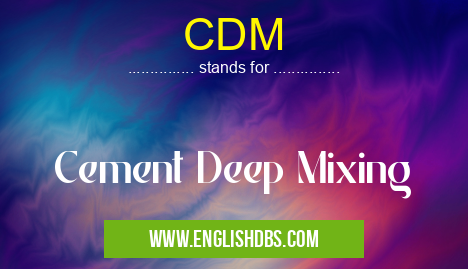What does CDM mean in ACADEMIC & SCIENCE
Cement Deep Mixing (CDM) is an innovative construction method that uses cement-bentonite slurries to construct strong and stable deep foundations. This method has been used for a variety of projects, such as improving the stability of bridge abutments, creating remediation barrier walls for contaminated sites, and making safer embankments for roads.

CDM meaning in Academic & Science in Academic & Science
CDM mostly used in an acronym Academic & Science in Category Academic & Science that means Cement Deep Mixing
Shorthand: CDM,
Full Form: Cement Deep Mixing
For more information of "Cement Deep Mixing", see the section below.
Essential Questions and Answers on Cement Deep Mixing in "SCIENCE»SCIENCE"
What is Cement Deep Mixing?
Cement Deep Mixing (CDM) is a construction method that uses a cement-bentonite slurry to create strong and stable deep foundations. The slurry is pumped into boreholes drilled in the soil and forms columns when they harden. These columns help improve the stability and strength of the foundation.
How does CDM work?
In the CDM process, boreholes are first drilled into the ground and then filled with water-cement-bentonite slurry. The slurry is pumped into the holes and allowed to harden which creates dense cemented columns beneath the surface of the soil. Once hardened, these columns help improve stability and strength of structures built on top or in close proximity of them.
What are some applications of CDM?
CDM can be used for a variety of projects including bridge abutments, remediation barrier walls for contaminated sites, earthworks for roads or embankments, and much more. It provides improved safety and stability compared to other construction methods due to its ability to construct deep foundations that remain strong over time even under large loads or high water pressures.
What are the advantages of using CDM?
The main advantage of using CDM is its ability to construct deep foundations quickly with minimum disturbance to nearby structures or buildings. It also requires less labor compared to traditional construction methods since it only requires drilling holes into the ground and filling them with slurry instead of excavating large amounts of soil during installation. Other advantages include improved safety due to stronger foundations, better overall performance through increased stability at deeper depths than traditional methods can provide, less material consumption due to quickly setting up materials such as reinforced concrete piles or H beams after installation, and cost efficiency due to its quick setup time resulting in lower labor costs associated with traditional methods of construction.
Final Words:
Cement Deep Mixing (CDM) is an innovative construction method that offers many benefits over traditional methods when it comes to creating strong and stable foundations for bridges, roads, etc.. Unlike traditional methods where much manual labor would be required along with excavation work in order to build strong foundations - CDM can do this quickly while causing minimal disruption around nearby buildings or structures due to its use of cemented columns created through pumping a special mixture into boreholes drilled into the ground underneath them.
CDM also stands for: |
|
| All stands for CDM |
